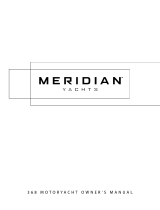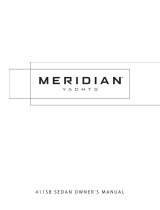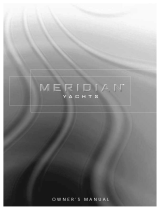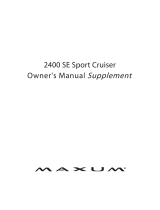Page is loading ...



Date of Purchase __________________________________________________
Port Engine Serial Number: _________________________________________
Starboard Engine Serial Number: ____________________________________
Hull Identification Number:__________________________________________
Hull Identification Number
•The Hull Identification Num-
ber (HIN) is located on the
starboard side of the transom.
•Record the HIN (and the
engine serial numbers) in the
space provided above.
•Please refer to the HIN for
any correspondence or orders.
© 2003 Meridian Technical Publications. All rights reserved.
No part of this publication may be reproduced, stored in any retrieval system, or transmitted in any form by any means, electronic, mechanical, photocopy-
ing, recording or otherwise, without prior written permission of Meridian.
Printed in the United States of America.
General Notes
The material in this document is for information only and is subject to change without notice. While reasonable efforts have been made in the preparation of
this document to assure its accuracy, Meridian assumes no liability resulting from errors or omissions in this document, or from the use of information con-
tained herein.
Due to our commitment to product improvement, Meridian reserves the right to make changes in the product design, specifications, and equipment at any
time without notice or obligation. Illustrations and/or photos may show optional equipment.
All Meridian products meet or exceed USCG (Unites States Coast Guard) and/or NMMA (National Marine Manufacturer’s Association) construction stan-
dards. Manufactured with 1,1,1 Trichloroethane, a substance which harms public health and environment during the manufacturing process by destroying
ozone in the upper atmosphere.
Proprietary Rights
This document discloses subject matter in which Meridian has proprietary rights. The information and design disclosed herein were originated by and are the
property of Meridian. Neither receipt nor possession thereof confers or transfers any right to reproduce, copy, alter or disclose the document or any part
thereof, any information contained therein, or to construct boats or any item from it, except by written permission from or written agreement with Meridian.
This document is to be returned upon request to Meridian.
HIN LOCATION

CONTENTS
1 Chapter 1: Welcome Aboard!
1 Dimensions and Tank Capacities
1 Layout View
1 Dealer Service
2 Warranty Information
2 Boating Experience
2 Engines & Accessories Guidelines
2 Engine & Accessories Literature
3 Safety Standards
3 Qualified Maintenance
3 Structural Limitations
4 Special Care For Moored Boats
4 Sacrificial Anodes (Zincs)
5 Boat Lifting
6 Carbon Monoxide (CO)
6 Facts about CO
7 Where and How CO Can Accumulate
7 How to Protect Yourself and Others From CO
8 Trip Checklist
8 Monthly Checklist
8 Annual Checklist
8 Carbon Monoxide Alarm System
9 More Information
10 Chapter 2: Locations
10 Exterior Views
10 Hull Views
11 Deck View
12 Aft Deck Views
13 Helm Stations
15 Component Locations
27 Chapter 3: Propulsion &
Related Systems
27 Engine
28 Exhaust System
29 Engine Room Ventilation System
30 Fuel System
31 Fuel Fills & Vents
31 Fuel Transfer Pump (Diesel Engines Only)
32 Fuel Filters
32 Anti-siphon Valve (Gas Engines Only)
32 Oil Change System
(If Equipped)
32 Fire Suppression System (If Equipped)
33 Shaft-Transmission Alignment
34 Chapter 4: Controls and Gauges
34 Steering
34 Rudder Stuffing Gland
35 Autopilot (If Equipped)
35 Shift/Throttle Controls
35 Engine Synchronization (If Equipped)
36 Trim Tabs
37 Docking On Command (D.O.C.) System
(If Equipped)
38 Gauges
38 Cleaning Gauges
38 Gauge Fogging
38 Radio Transmission Interference
38 Twin Engine Readings
38 Fuel Gauge
38 Synchronizer
39 Chapter 5: Navigation &
Communication Equipment
39 Compass
39 Global Positioning System (GPS)
(If Equipped)
39 Depth Finder
40 VHF Radio (If Equipped)
40 Radar (If Equipped)

41 Chapter 6: Plumbing
41 Bilge Pumps
43 Autofloat Switches
44 Seawater Systems
44 Seacocks
44 Seawater Strainers
45 Raw Water Washdown (If Equipped)
46 Freshwater System
47 Freshwater System Winterization
48 Water Heater
48 Winterizing the Water Heater
49 Transom Shower
49 City Water Inlet
50 Drain Systems
50 Deck Drains
50 Sink Drains
50 Shower Drain System
50 Sump Box Cleaning
50 Sump System Winterization
51 Marine Head with Holding Tank
51 Electric Head
52 Macerator (If Equipped)
53 VacuFlush (If Equipped)
54 Chapter 7: Deck Equipment
54 Cleats
54 Windlass (If Equipped)
55 Davit (If Equipped)
56 Canvas
57 Chapter 8: Appliances &
Entertainment Systems
57 Refrigerator
57 Range/Oven
57 Audio & Visual Equipment
58 Dockside Television & Telephone Inlet
59 Chapter 9: Lights
59 Care and Maintenance
59 Interior & Exterior Lights
59 Spotlight (If Equipped)
60 Chapter 10: Heating & Air Conditioning
60 Air Conditioning System (If Equipped)
61 Electric Heaters (If Equipped)
61 Heat Exchanger Cabin Heat (If Equipped)
62 Chapter 11: Electrical System
63 12-Volt DC System
63 Batteries
63 Fuses and Circuit Breakers
63 12-Volt Accessory Outlet
64 Battery Switch
64 Alternators
64 Battery Charger
65 Alternating Current (AC) System
66 Shore Power
67 Connecting To Shore Power
67 Shore Power Cable Hoist (If Equipped)
68 Inverter Power (If Equipped)
68 Generator (If Equipped)
69 Generator Starting & Stopping
70 Electrical Routings
70 Alternating Current Electrical Harness
71 Direct Current Electrical Harness
72 Wiring Diagrams
72 120/240-Volt AC Electrical System
(If Equipped)
73 12-Volt Auxiliary DC Electrical System
74 Engine Electrical System
75 Important Records
76 Float Plan

Hazard Boxes & Symbols
The hazard boxes and symbols shown below are used throughout this manual to call attention to potentially danger-
ous situations which could lead to either personal injury or product damage. Read ALL warnings carefully and fol-
low all safety instructions.
DANGER!
!
This box alerts you to immediate hazards which WILL cause severe personal injury or death if
the warning is ignored.
This box alerts you to hazards or unsafe practices which COULD result in severe personal
injury or death if the warning is ignored.
WARNING!
!
This box alerts you to hazards or unsafe practices which COULD result in minor personal
injury or cause product or property damage if the warning is ignored.
CAUTION!
!
NOTICE
This box calls attention to installation, operation or maintenance information, which is impor-
tant to proper operation but is not hazard related.
EXPLOSION
HAZARD! NO OPEN
FLAME! HOT
HAZARD!
ROTATING
PROPELLER HAZARD!
FALLING
HAZARD!
ELECTRICAL
HAZARD!
CO POISONING
HAZARD!
FIRE
HAZARD!
RUN BILGE BLOWERS
FOR 4 MINUTES!

1
490 Motoryacht • Owner’s Manual
Chapter 1: Welcome Aboard!
•This Owner’s Manual provides specific information about your yacht.
•Additional information about safe operating practices, general boating regulations, and proper maintenance
techniques is included in the Cruiser & Yacht Owner’s Manual Supplement.
•The engine and accessories installed on your boat come with their own operation and maintenance manuals.
•Unless noted otherwise, all engine and accessory literature referred to in this Owner’s Manual is included in
your owner’s packet.
•Before using your yacht, study this Owner’s Manual, the Cruiser & Yacht Owner’s Manual Supplement, and
all engine and accessory literature carefully.
•Keep this Owner’s Manual, the Cruiser & Yacht Owner’s Manual Supplement, and all owner’s packet litera-
ture, on your yacht in a secure, yet easy to get to place.
Dimensions and Tank Capacities
Layout View
Dealer Service
•Ask your dealer to explain all systems before taking delivery of your yacht.
•Your dealer is your key to service.
•Contact your dealer if you have any questions or problems with your new yacht.
•If your dealer cannot help, call our customer service hotline: 360-403-2198 or send us a FAX: 360-403-1158.
•Buy replacement parts from any authorized Meridian dealer.
Over-
all
Length
Bridge
Clear-
ance Beam Draft
(Hull) Draft
(Maximum) Fuel Capac-
ity (gal.) Freshwater
Capacity
(gal.)
Waste Holding
Tank Capacity
(gal.)
47' 4" 18' 2" 14' 11" 2' 11" 3' 4" 444 200 48

Chapter 1: Welcome Aboard! 490 Motoryacht • Owner’s Manual
2
Warranty Information
•Meridian offers an Express Limited Transferable Warranty on each new Meridian purchased through an
authorized Meridian dealer.
•A copy of the Express Limited Transferable Warranty was included in your owner’s packet.
•If you did not receive a copy of the Express Limited Transferable Warranty, please contact your dealer or
call 360-403-2198 for a copy.
Boating Experience
If this is your first yacht or if you are changing to a type of yacht you are not familiar with, obtain handling and
operating experience before assuming command of the yacht.
Take one of the boating safety classes offered by the U.S. Power Squadrons or the U.S. Coast Guard Auxiliary.
For more course information, including dates and locations of upcoming classes, contact the organizations
directly:
•U.S. Power Squadrons: 1-888-FOR-USPS (1-888-367-8777) or on the Internet at: http://www.usps.org
•In Canada, for the CPS courses call 1-888-CPS-BOAT.
•U.S. Coast Guard Auxiliary: 1-800-368-5647 or on the Internet at: http://www.cgaux.org
Outside the United States, your selling dealer, national sailing federation or local boat club can advise you of
local sea schools or competent instructors.
Engines & Accessories Guidelines
•Your yacht’s engines and accessories were selected to provide optimum performance and service.
•Installing different engines or other accessories may cause unwanted handling characteristics.
•Should you choose to install different engines or to add accessories that will affect the yacht’s running trim,
have an experienced marine technician perform a safety inspection and handling test before operating your
yacht again.
•Certain modifications to your yacht will result in the cancellation of your warranty protection. Always
check with your dealer before making any modifications to your yacht.
Engine & Accessories Literature
•The engines and accessories installed on your boat come with their own operation and maintenance manuals.
•Read and understand these manuals before using the enginse and accessories.
•Unless noted otherwise, all engine and accessory literature referred to in this Owner’s Manual is included in
your owner’s packet.
CONTROL HAZARD!
A qualified operator must be in control of the yacht at all times. DO NOT operate your
yacht while under the influence of alcohol or drugs.
WARNING!
!
NOTICE
When storing your yacht please refer to your engine’s operation and maintenance manu-

490 Motoryacht • Owner’s Manual Chapter 1: Welcome Aboard!
3
Safety Standards
Your yacht’s mechanical and electrical systems were designed to meet safety standards in effect at the time it
was built. Some of these standards were mandated by law, all of them were designed to insure your safety, and
the safety of other people, vessels and property.
In addition to this Owner’s Manual, please read the Cruiser & Yacht Owner’s Manual Supplement and all
accessory instructions for important safety standards and hazard information.
Qualified Maintenance
•Failure to maintain your yacht’s systems (listed in the warning above) as designed could violate the laws in
your jurisdiction and could expose you and other people to the danger of bodily injury or accidental death.
•Follow the instructions provided in the Cruiser & Yacht Owner’s Manual Supplement, this Owner’s Manual,
the engine owner’s manual and all accessory literature.
Structural Limitations
The command bridge, bow platform, and transom platform are designed to be lightweight for proper yacht bal-
ance. The load limit for these platforms is 30 pounds per square foot, evenly distributed.
FALLING and ROTATING PROPELLER HAZARD!
NEVER allow anyone to ride on parts of the yacht not designed for
such use.
•Sitting on seat backs, lounging on the forward deck, bow riding, gunwale riding or occu-
pying the transom platform while underway is especially hazardous and will cause per-
sonal injury or death.
DANGER!
!
ROTATING PROPELLER and CARBON MONOXIDE
POISONING HAZARD!
•NEVER allow anyone to occupy, or hang from, the
back deck or swim platform while the engine(s)
are running.
•Teak surfing, dragging, or water skiing within 20
feet of a moving watercraft can be fatal.
DANGER!
!
DANGER
PERSONAL SAFETY HAZARD!
ALWAYS secure the anchor and other loose objects before getting underway. The anchor
and other items that are not properly secured can come loose when the yacht is moving and
cause personal injury or death.
DANGER!
!
To maintain the integrity and safety of your yacht, allow only qualified personnel to per-
form maintenance on, or in any way modify: The steering system, propulsion system,
engine control system, fuel system, environmental control system, electrical system or navi-
WARNING!
!

Chapter 1: Welcome Aboard! 490 Motoryacht • Owner’s Manual
4
Special Care For Moored Boats
•Whether moored in saltwater or freshwater, your yacht will collect marine growth on its hull bottom.
•This will detract from the yacht’s beauty, greatly affect its performance and may damage the gelcoat.
•There are two methods of slowing marine growth:
1. Periodically haul the yacht out of the water and scrub the hull bottom with a bristle brush and a solution
of soap and water.
2. Occasionally re-paint the hull below the waterline with a good grade of anti-fouling paint.
Sacrificial Anodes (Zincs)
Your yacht features sacrificial anodes (zincs) to protect underwater metal parts from excessive deterioration.
Check the zincs regularly and replace them if they have deteriorated more than 70%.
There are many factors that affect the rate at which the zincs deteriorate, including:
•Water temperature
•Salinity
•Water pollution
Stray electrical current from the yacht or dock may cause complete deterioration in just a few weeks. If there is
rapid zinc deterioration, measure the electrolytic corrosion around your yacht with a corrosion test meter. If the
zincs are not bonded correctly, they will not provide protection.
•To help seal the hull bottom and reduce the possibility of gelcoat blistering on moored
boats, apply an epoxy barrier coating. The barrier coating should be covered with sev-
eral coats of anti-fouling paint.
•Many states regulate the chemical content of bottom paints in order to meet environ-
mental standards. Check with your local dealer about recommended bottom paints, and
about the laws in effect in your area.
NOTICE
Do not paint between the zinc and the metal surface it contacts and do not paint over the
NOTICE
NEW SACRIFICIAL ANODE DETERIORATED SACRIFICIAL ANODE

490 Motoryacht • Owner’s Manual Chapter 1: Welcome Aboard!
5
Boat Lifting
•Always follow the lift equipment’s
instructions and requirements.
•Water in the bilge can shift and change
the balance of the load.
•If water is present in the bilge, pump or
drain the water out of the bilge areas
before lifting your yacht.
•When lifting your yacht, always posi-
tion the lifting slings at the port and
starboard, lifting sling label positions,
as shown in the illustration on the right.
PERSONAL INJURY and /or PRODUCT OR PROPERTY DAMAGE HAZARD!
•Lifting slings may slip on the hull.
•Avoid serious injury or death by securing the lifting slings together before lifting.
WARNING!
!
PERSONAL INJURY and /or PRODUCT OR PROPERTY DAMAGE HAZARD!
•NEVER lift the yacht using the bow and stern eyes.
WARNING!
!
PRODUCT or PROPERTY DAMAGE HAZARD!
•When lifting any yacht, always use a spreader bar. The spreader bar must be equal to
the width of the yacht at each lifting point.
CAUTION!
!
110" 364"
LIFTING SLING LABELS
(TYPICAL PORT & STARBOARD)

Chapter 1: Welcome Aboard! 490 Motoryacht • Owner’s Manual
6
Carbon Monoxide (CO)
Facts about CO
•CO poisoning causes a significant number of boating deaths each year.
•Called the "silent killer", CO is an extremely toxic, colorless, odorless and tasteless gas.
•CO can harm or even kill you inside or outside your yacht.
•CO can affect you whether you’re underway, moored, or anchored.
•CO symptoms are similar to seasickness or alcohol intoxication.
•CO can make you sick in seconds. In high enough concentrations, even a few breaths can be fatal.
•Breathing CO blocks the ability of your blood to carry oxygen.
•The effects are cumulative, even low levels of exposure can result in injury or death.
Factors That Increase the Effects of CO Poisoning
•Age
•Smokers or people exposed to high concentrations of cigarette smoke
•Consumption of alcohol
•Lung disorders
•Heart problems
•Pregnancy
•Carbon monoxide gas (CO) is colorless, odorless, tasteless, and
extremely dangerous.
•All engines, generators, and fuel burning appliances produce CO
as exhaust.
•Prolonged exposure to low concentrations or very quick exposure to high
concentrations will cause BRAIN DAMAGE or DEATH.
•Teak surfing, dragging, or water skiing within 20 feet of a moving water-
craft can be fatal.
DANGER!
!

490 Motoryacht • Owner’s Manual Chapter 1: Welcome Aboard!
7
Where and How CO Can Accumulate
Stationary Conditions That Increase CO Accumulations Include:
To correct stationary situations A and/or B:
•Close all windows, portlights and hatches.
•If possible, move your yacht away from source of CO.
Running Conditions That Increase CO Accumulations Include:
To correct running situations C and/or D:
•Trim bow down.
•Open windows and canvas.
•When possible, run yacht so that prevailing winds help dissipate exhaust.
How to Protect Yourself and Others From CO
•Know where and how CO may accumulate in and around your yacht (see above).
•Maintain fresh air circulation throughout the yacht at all times.
•Know where your engine and generator exhaust outlets are located and keep everyone away from these areas.
•Never sit on, or hang onto, the back deck or swim platform while the engine(s) are running.
•Never enter the areas under swim platforms where exhaust outlets are located.
•Although CO can be present without the smell of exhaust fumes, if exhaust fumes are detected on the yacht,
take immediate action to dissipate these fumes.
•Treat symptoms of seasickness as possible CO poisoning. Get the person into fresh air immediately. Seek
medical attention—unless you’re sure it’s not CO.
•Install and maintain CO alarms inside your yacht. Do not ignore any alarm. Replace alarms as recommended
by the alarm manufacturer.
•Follow the checklists provided on the next page.
•Get a Vessel Safety Check.
For information on how to get a free VESSEL SAFETY CHECK, visit www.vesselsafetycheck.org or contact
your local U.S. Coast Guard Auxiliary or United States Power Squadrons®.
•U.S. Coast Guard Auxiliary: 1-800-368-5647 or on the Internet at: http://www.cgaux.org
•U.S. Power Squadrons: 1-888-FOR-USPS (1-888-367-8777) or on the Internet at: http://www.usps.org
A. Using engine,
generator, or
other fuel
burning
device when
yacht is
moored in a confined space.
B. Mooring too close to another boat that is using
C. Running yacht with trim angle of bow too high. D. Running yacht without through ventilation
(station wagon effect).

Chapter 1: Welcome Aboard! 490 Motoryacht • Owner’s Manual
8
Trip Checklist
o Make sure you know where the exhaust outlets are located on your yacht.
o Educate all passengers about the symptoms of CO poisoning and where CO may accumulate.
o When docked, or rafted with another boat, be aware of exhaust emissions from the other boat.
o Confirm that water flows from the exhaust outlet when the engines and generator are started.
o Listen for any change in exhaust sound, which could indicate an exhaust component failure.
o Test the operation of each CO alarm by pressing the test button.
Monthly Checklist
oMake sure all exhaust clamps are in place and secure.
o Look for exhaust leaking from exhaust system components. Signs include rust and/or black streaking, water
leaks, or corroded or cracked fittings.
o Inspect rubber exhaust hoses for burned, cracked, or deteriorated sections. All rubber hoses should be pliable and
free of kinks.
Annual Checklist
Have a Qualified Marine Technician:
o Replace exhaust hoses if cracking, charring, or deterioration is found.
o Ensure that your engines and generators are properly tuned, and well maintained.
o Inspect each water pump impeller and the water pump housing. Replace if worn. Make sure cooling systems are
in working condition.
oInspect all metal exhaust parts for cracking, rusting, leaking, or loosening and check the cylinder head gasket,
exhaust manifold, water injection elbow, and the threaded adapter nipple between the manifold and the elbow.
o Clean, inspect, and confirm proper operation of the generator cooling water anti-siphon valve (if equipped).
Carbon Monoxide Alarm System
•Your yacht features a carbon monoxide (CO) alarm system.
•Do not disconnect the alarm system.
•Read and understand the manufacturer’s instructions for your CO alarm system. If you did not receive an instruc-
tion manual, call (800) 383-0269 and one will be mailed to you.
If your yacht is not equipped with a carbon monoxide alarm, consider purchasing one from your dealer or marine
supply store.
DANGER
CARBON MONOXIDE POISONING HAZARD!
•The house battery switch must be in the On position for the CO Monitors
to work.
•If your yacht will be unattended for an extended period of time, turn Off
the house battery or the CO Monitors will drain the house battery.
DANGER!
!
The stereo memory and CO monitor(s) place a small, but constant drain on the battery. If
your yacht will be unattended for an extended amount of time, plug into shore power with
the battery charger turned On, or disconnect the battery if shore power is not an option.
NOTICE

490 Motoryacht • Owner’s Manual Chapter 1: Welcome Aboard!
9
More Information
For more information about how you can prevent carbon monoxide poisoning on recreational boats and other
ways to boat more safely, contact:
For information on how to get a free VESSEL SAFETY CHECK, visit www.vesselsafetycheck.org or contact
your local U.S. Coast Guard Auxiliary or United States Power Squadrons®.
•U.S. Coast Guard Auxiliary: 1-800-368-5647 or on the Internet at: http://www.cgaux.org
•U.S. Power Squadrons: 1-888-FOR-USPS (1-888-367-8777) or on the Internet at: http://www.usps.org
United States Coast Guard
Office of Boating Safety (G-OPB-
3)
2100 Second Street SW
Washington, DC 20593
www.uscgboating.org
1-800-368-5647
National Marine Manufacturers
Association (NMMA)
200 East Randolph Drive
Suite 5100
Chicago, IL 60601-9301
www.nmma.org
312-946-6200
American Boat & Yacht Council,
Inc. (ABYC)
3069 Solomon’s Island Road
Edgewater, MD 21037-1416
www.abycinc.org
410-956-1050

10
490 Motoryacht • Owner’s Manual
Chapter 2: Locations
Exterior Views
Hull Views
TRIM TAB TRIM TABSSACRIFICIAL
ZINC ANODE
PLATE
CLEAT
CITY
WATER
STARBOARD HULLSIDE
PORT HULLSIDE
PORTLIGHTS
PORTLIGHTS
ENGINE ROOM
BLOWER VENT
ENGINE ROOM
BLOWER VENT
WATER TANK
VENTS FUEL TANK
VENT
FUEL TANK
VENT
HOLDING
TANK VENT
ANCHOR
LOCKER DRAIN
CLEAT
CHAIN LOCKER
DRAIN
DECK
DRAIN ENTERTAINMENT SINK
& AIR CONDITIONER DRAIN MACERATOR
(IF EQUIPPED)
, FORWARD
& MID BILGE PUMP DRAIN
AIR CONDITIONER
DRAIN SINK
DRAIN HOT WATER
HEATER DECK
DRAIN AFT BILGE
PUMP DRAINS
PORT
EXHAUST
GENERATOR
EXHAUST
PORT COCKPIT
DRAIN
STARBOARD
EXHAUST
STARBOARD
COCKPIT DRAIN
STARBOARD COCKPIT
HATCH DRAIN
PORT COCKPIT
HATCH DRAIN CENTER COCKPIT
HATCH DRAINS
WASHER/DRYER DRAIN
(IF EQUIPPED)

490 Motoryacht • Owner’s Manual Chapter 2: Locations
11
Deck View
BOW
HATCHES
WINDLASS
CONTROLS CLEAT
CLEAT BOW
NAV LIGHT
ANCHOR
WINDLASS
ANCHOR
LOCKER SPOT-
LIGHT
BOW
HATCHES
WINDSHIELD WIPERS

Chapter 2: Locations 490 Motoryacht • Owner’s Manual
12
Aft Deck Views
CLEATBOARDING
LADDER CITY WATER
INLET
AFT NAVIGATION
LIGHT
FRESH WATER/RAW
WATER HATCH
(IF EQUIPPED)
CLEAT GRAB RAIL

490 Motoryacht • Owner’s Manual Chapter 2: Locations
13
Helm Stations
Pilothouse Helm Station
ACTUAL LAYOUTS MAY VERY DEPENDING
ON ENGINE AND ACCESSORY OPTIONS
NOTE: TYPICAL HELM LAYOUTS SHOWN
DEFOGGER 12 VOLT
RECEPTACLE
FUEL
GAUGE VOLTMETER
TACHOMETER
TEMPERATURE
GAUGE
TACHOMETER
FUEL
GAUGE
TEMPERATURE
GAUGE
OIL PRESSURE
GAUGE
OIL PRESSURE
GAUGE SYCHRONIZER GAUGE
(IF EQUIPPED)
WATER TEMPERATURE
GAUGE
(IF EQUIPPED)
VOLTMETER
COMPASS
SHIFTER
LEVERS THROTTLE
LEVERS SWITCH
PANEL DEFOGGER

Chapter 2: Locations 490 Motoryacht • Owner’s Manual
14
Command Bridge Helm Station
ACTUAL LAYOUTS MAY VERY DEPENDING
ON ENGINE AND ACCESSORY OPTIONS
NOTE: TYPICAL HELM LAYOUTS SHOWN
TEMPERATURE
GAUGE VOLTMETER
OIL PRESSURE
GAUGE TACHOMETER
COMPASS
TACHOMETER
TEMPERATURE
GAUGE
VOLTMETER
OIL PRESSURE
GAUGE
DEPTH
FINDER
SWITCH
PANEL
SPOTLIGHT
CONTROL PANEL
(IF EQUIPPED)
TRIM
TABS
BATTERY PARALLEL
SWITCH
IGNITION
PANEL
/





